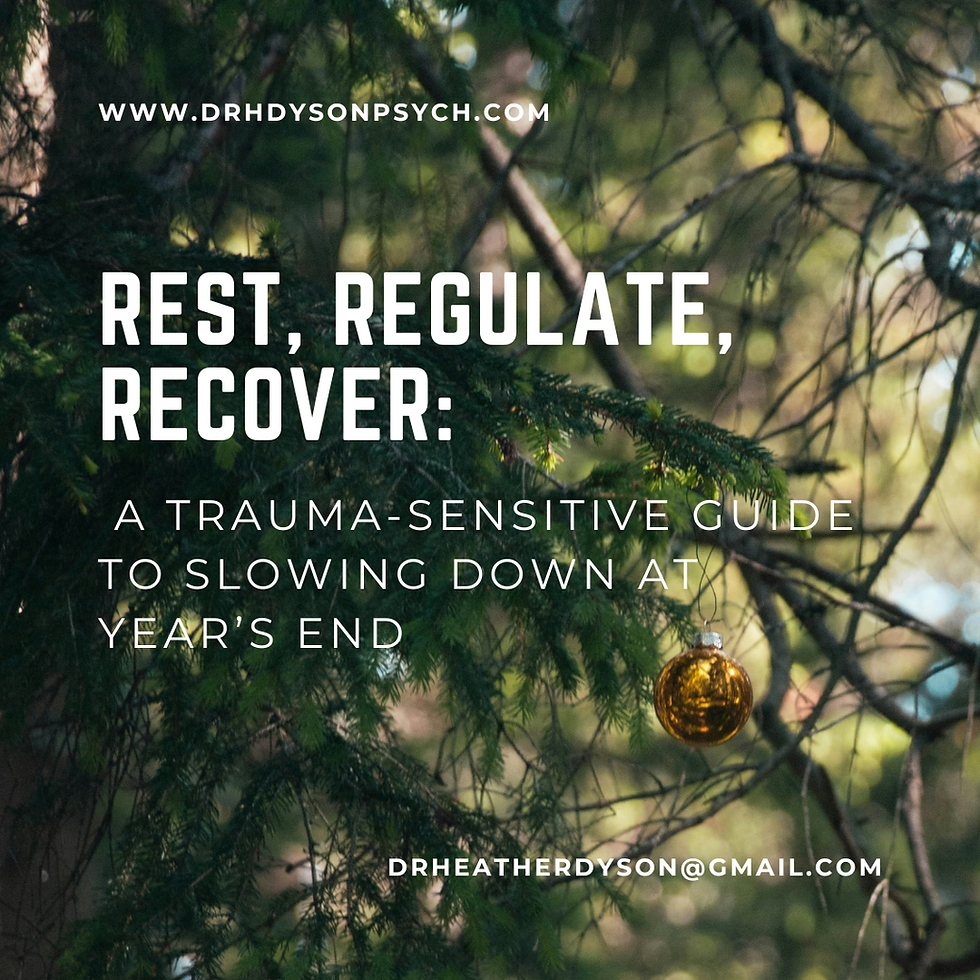Beyond the Stigma: Dispelling Common Myths about PTSD and Trauma
- Dr Heather Dyson

- Apr 18, 2023
- 4 min read
Post-Traumatic Stress Disorder (PTSD) is a condition that can develop in individuals who have experienced or witnessed a traumatic event. Despite the growing awareness of PTSD, there are still many common myths and misconceptions surrounding this condition. These myths can prevent people from seeking the help they need, lead to misunderstandings, and contribute to the stigma surrounding PTSD. In this blog post, we will dispel some of the most common myths about PTSD and trauma.

Myth 1: Only military personnel get PTSD.
While it is true that many veterans develop PTSD, this condition can affect anyone who has experienced or witnessed a traumatic event. Trauma can be caused by a wide range of experiences, including sexual assault, domestic violence, natural disasters, car accidents, and childhood abuse. In fact, the National Centre for PTSD reports that about 8% of the U.S. population will develop PTSD at some point in their lives.
Myth 2: People with PTSD are weak.
This myth is not only false, but it is also harmful. People who develop PTSD have experienced or witnessed a traumatic event that overwhelmed their ability to cope. PTSD is not a sign of weakness, but rather a normal response to an abnormal situation. People with PTSD have demonstrated incredible strength in surviving their traumatic experiences and continuing to live their lives despite the challenges they face.
Myth 3: PTSD is a rare condition.
PTSD is more common than many people realize. As previously mentioned, about 8% of the U.S. population will develop PTSD at some point in their lives. This means that millions of people are living with this condition. However, because of the stigma surrounding mental illness, many people with PTSD may not seek help or talk openly about their experiences.
Myth 4: PTSD is only caused by one traumatic event.
While PTSD can develop as a result of a single traumatic event, it can also be caused by ongoing exposure to trauma. For example, people who work in high-stress professions such as first responders or healthcare workers may develop PTSD as a result of the cumulative stress they experience on the job. Additionally, people who experienced childhood trauma may develop complex PTSD, which is caused by ongoing trauma or abuse.
Myth 5: PTSD is only caused by physical violence.
PTSD can be caused by any type of trauma, including emotional, psychological, and sexual abuse. In fact, sexual assault is one of the most common causes of PTSD. It is important to recognise that trauma comes in many forms and that all survivors of trauma deserve support and understanding.
Myth 6: PTSD is a lifelong condition.
While some people may experience symptoms of PTSD for many years, it is important to recognise that PTSD is treatable. With the right treatment, many people with PTSD are able to manage their symptoms and live fulfilling lives. Treatment for PTSD can include therapy, medication, and self-care techniques such as exercise and mindfulness. You can find out some further information about some of the various treatment options available for individuals suffering with symptoms associated with PTSD here à https://www.drhdysonpsych.com/post/treatment-for-trauma-four-therapeutic-options
Myth 7: People with PTSD are dangerous.
This myth is not only false, but it is also harmful. People with PTSD are no more likely to be violent than anyone else. In fact, people with PTSD are more likely to be the victims of violence than the perpetrators. It is important to recognise that people with PTSD are individuals with their own unique experiences and personalities.
Myth 8: Only weak people get PTSD.
As previously mentioned, PTSD is not a sign of weakness. It is a normal response to an abnormal situation. People with PTSD have experienced or witnessed a traumatic event that overwhelmed their ability to cope. It takes incredible strength to survive a traumatic event and continue to live your life despite the challenges you face.
Myth 9: PTSD is always immediately apparent.
PTSD symptoms may not appear immediately after a traumatic event. In fact, it is common for symptoms to develop over time, sometimes weeks or even months after the event. Some people may experience symptoms intermittently or only in certain situations. It is important to recognise that everyone's experience with PTSD is unique and that symptoms may vary from person to person.
Myth 10: People with PTSD can just "get over it".
This myth is not only false, but it is also harmful. PTSD is a complex condition that requires professional treatment. Telling someone to "get over it" minimizes their experience and can make them feel ashamed or embarrassed about seeking help. It is important to recognise that PTSD is a serious condition that requires understanding, compassion, and proper treatment.
Dispelling these common myths about PTSD and trauma is crucial in promoting understanding and empathy for those who are living with this condition. It is important to remember that PTSD is not a weakness, but rather a normal response to an abnormal situation. Seeking help is a sign of strength and resilience, and it is never too late to start the journey towards healing and recovery.
If you or someone you know is struggling with PTSD, there is help available. There are numerous organisations and charities (NHS, IAPT, Combat Stress, Mind, Samaritans, Anxiety UK, Rape Crisis England & Wales, Survivors UK, The Trauma Centre, etc etc) who may be able to offer you access to therapeutic services. For others who may want to consider private therapy, ensure that your psychologist is registered with the HCPC (https://www.hcpc-uk.org/check-the-register/).
Don't let stigma or misconceptions prevent you from seeking the help you need. You are not alone, and there is hope for healing and recovery.
Photo by Artem Maltsev on Unsplash




Comments